#ancient britain
Text

The summer solstice has dawned over Stonehenge for millennia.
#Stonehenge#Wiltshire#Salisbury Plain#English countryside#dawn#prehistoric#stone circle#summer solstice#sunrise#ancient Britain#Druidism#paganism#mystical#England
77 notes
·
View notes
Text
Must Farm is an amazing site. I'd love to do a road trip to visit this and then up to Vindolanda.
11 notes
·
View notes
Text
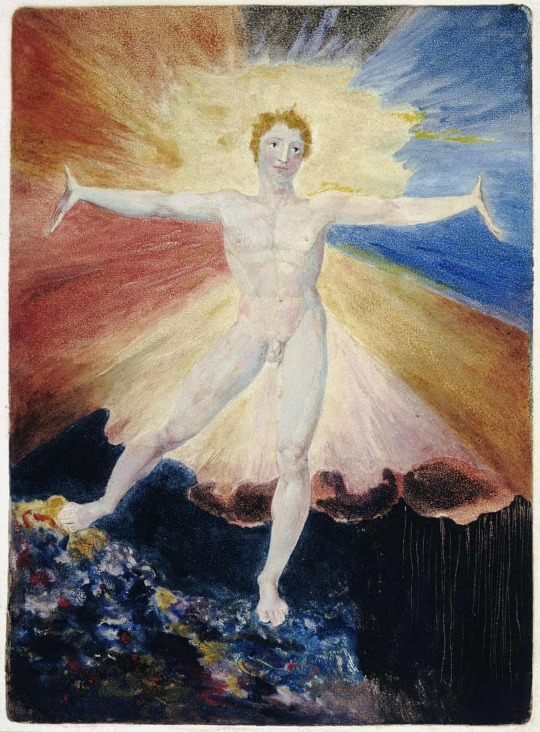
William Blake (British/English, 1757-1827) • Albion • 1793 • British Museum
In Blake's mythology, Albion was the primeval man whose fall and division results in the FourZoas: Urizen, Tharmas, Luvah/Orc and Urthona/Los. The name derives from the ancient and mythological name of Britain, Albion. – Wikipedia
This image exists as drawing, engraving, colour printed etching and watercolour.
#art#painting#fine art#art history#william blake#british artist#british poet#watercolour#etching#drawing#18th century british art#british museum#mythology#ancient britain#pagan sphinx art blog#art blogs on tumblr
18 notes
·
View notes
Text
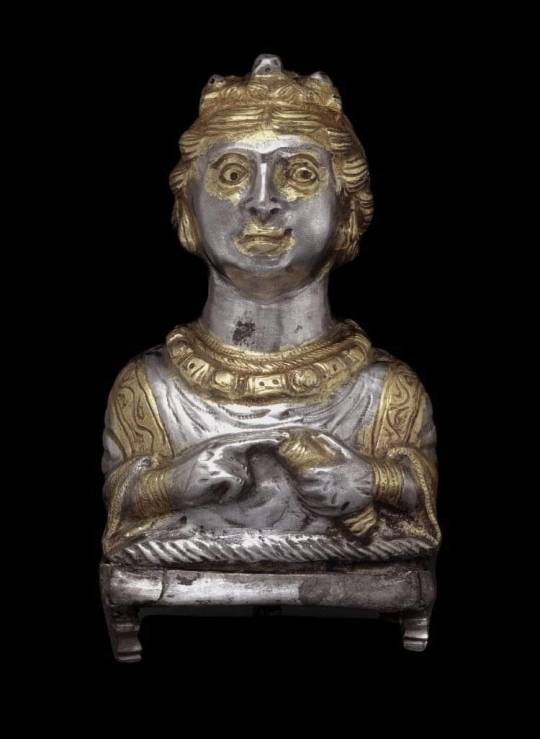
A silver pepper pot in anthropomorphic form. Roman Britain, buried in the 5th century AD, from Hoxne, Suffolk.
The pepper pot was found in 1992 by a farmer who was using his metal detector to search for a lost hammer. He found his hammer – it is now in the British Museum – but also a hoard of over 15,000 gold and silver coins, gold jewellery and numerous small items of silver tableware. The coins in the hoard establish that its burial took place some time after AD 407/8. Only a very wealthy family could have owned such treasures. We do not know the identity of the person who buried it but several objects are inscribed with the name Aurelius Ursicinus.
The pepper pot is in the shape of a wealthy well-fed woman wearing late Roman fashions. She wears a sleeved undergarment with tight gilded cuffs at the wrists, and a wide-sleeved over tunic with stripes of gilded and engraved decoration over the shoulders representing appliqued bands of embroidered or patterned textile (clavi).
Her golden (gilded) hair is done up in an intricate style that was often represented in late Roman art: the hair is parted in the middle, with rolls at the sides. The back hair is worked into a flat series of twisted locks at the neck that are drawn up over the back of the head, turned under at the front, and held in place with hairpins. Three knobs at the front and another at the crown of the head represent the ungilded hairpins.
Almond-shaped earrings and a necklace of large beads are depicted in relief and gilded, and there is additional gilding on the face, covering not only the eyes but the entire eye sockets, and the mouth, so as the flames from oil lamps flickered, the face would have seemed to come alive.
She holds a gilded scroll in her left hand, to which she points with the index finger of her right hand, probably to symbolise her learning and authority. We do not know if the figure represents a particular woman. ... It's ineffable.
Pepper was just one expensive luxury traded across the Indian Ocean in ancient times, as it did not grow in Britain or any other part of the Roman Empire. It was grown in India and to get to Suffolk, the pepper was transported by sea, river and over land.

https://www.britishmuseum.org/collection/object/H_1994-0408-33
http://www.teachinghistory100.org/objects/about_the_object/pepper_pot
https://upload.wikimedia.org/wikipedia/commons/thumb/1/1a/Hoxne_Hoard_28.jpg/800px-Hoxne_Hoard_28.jpg
spotted on Archaeologist Ticia Verveer's facebook page; https://www.facebook.com/100044382881604/posts/pfbid0UGcEJok8i67xeezyj2CLcKMJsbnLKAkWdy7NmP8TKZZ55opE4nU5fdVfqTSm7URXl/
#antique#ancient#archaeology#pepper#pepper pot#ancient history#ancient art#silver pepper pot#crowned figures#fashion history#ineffable inspiration#5th century ce#gilded figures#Aurelius Ursicinus#ancient roman art#ancient rome#ancient britain
179 notes
·
View notes
Text

Boudica (2023) poster
#cinema#movie poster#film#movie#boudica#ancient history#ancient rome#ancient britain#poster design#female empowerment#girl power#matriarchy
38 notes
·
View notes
Text
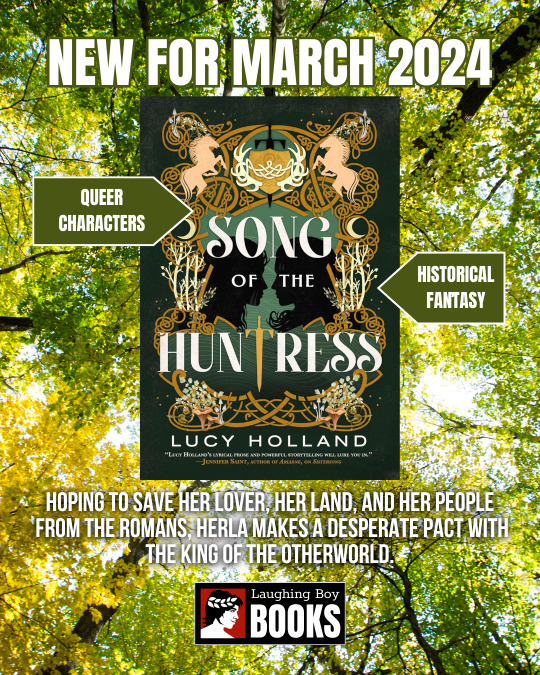
The acclaimed author of Sistersong transforms the story of Herla and the Wild Hunt into a rich, feminist fantasy in this stunning tale of two great warriors, a war-torn land, and an ancient magic that is slowly awakening.
Britain, 60AD. Hoping to save her lover, her land, and her people from the Romans, Herla makes a desperate pact with the king of the Otherworld. But years pass unheeded in his realm, and she escapes to find everyone she loved long dead. Cursed to wield his blade, she becomes Lord of the Hunt. And for centuries, she rides, leading her immortal warriors and reaping wanderers' souls. Until the night she meets a woman on a bloody battlefield--a Saxon queen with ice-blue eyes.
Queen Æthelburg of Wessex is a proven fighter. But when she leads her forces to disaster in battle, her husband's court turns against her. Yet King Ine needs Æthel more than ever. Something dark and dangerous is at work in the Wessex court. His own brother seeks to usurp him. And their only hope is the magic in Ine's bloodline that's lain dormant since ancient days.
The moment she and Æthel meet, Herla knows it's no coincidence. The dead kings are waking. The Otherworld seeks to rise, to bring the people of Britain under its dominion. And as Herla and Æthel grow closer, Herla must find her humanity--and a way to break the curse--before it's too late.
PURCHASE
#yabooks#youngadultbooks#yabookstagram#teenbooks#yalit#laughing boy books#historical fiction#historical romance#ancient britain#ya fantasy#fantasy novel#fantasy books#lgbtq books#gay books
6 notes
·
View notes
Text
Enchant the Heavens review
I've been revisiting a lot of my favorite old historicals since my beloved kitty Peggy died about a month ago, and one of them is Enchant the Heavens by Kathleen Morgan.
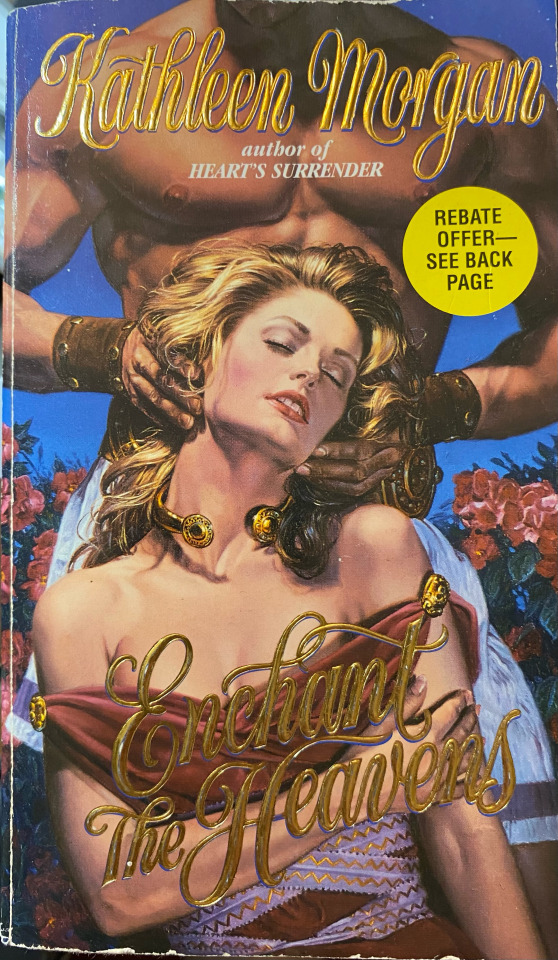
When I was a college student I loved romance novels, particularly historical romance, even though most of my friends at the time thought it was ridiculous and made fun of me for reading them. It made me even more stubborn, and I clung to the genre like a barnacle onto the hull of a ship. However, there was one book at the time that was too cheesy even for me, and that was Enchant the Heavens.
I found the cover embarrassing. Look, my teenage self thought, the hero’s hands look like he’s about to crack the heroine’s skull! And the hero, Marcus, was so earnest. The book was so earnest. The culture at the time was saturated with snark and irony, and sadly, I was not immune. I set the book down.
Years later, in 2011, I revisited Enchant the Heavens, and I found myself… well, enchanted. I was swept away by the epic nature of the story and the endearing characterizations. And I reread it just a week ago. I admit, I was afraid the suck fairy might’ve visited it over the intervening years. But I found myself devouring it happily just as I did all those years ago. And it’s good.
Enchant the Heavens was the first novel Kathleen Morgan ever wrote, and it was a labor of love. It’s a big, passionate, visceral, breathtakingly earnest romance.The story involves a British chieftain’s daughter, Rhianna, and the Roman governor’s nephew, Marcus, during Boudicca’s revolt, and their love is an anguished, star-crossed love that takes a great deal of blood and tears and hard work to resolve. Unlike most romances set during this period, the Celts aren’t romanticized into nature-loving New Agers, and the Romans aren’t evil. And neither the heroine or hero give up their cultures or identities in the end; in fact they work on uniting their communities in the aftermath of war. It’s mature and refreshing.
The language does have a lot of archaicisms that kind of annoying. ‘Twould! ’Twas! Naught! Okay… You just have to run with it. But if you’re willing to dive in, there is a lot to love about it. Rhianna is not afraid of revenge, or using her sword, which is really delightful (to avoid spoilers, I won’t tell you who she kills). Marcus is a reasonable guy too, but there’s just the right amount of deeply felt angst that is perfect for a story about forbidden love. Sometimes I feel that Marcus and Rhianna verge on being idealized archetypes then actual people, but it kind of fits with how epic and operatic the story is. (It really captures the vibe of ancient Irish stories like Deirdre, which was the author’s intention.) The author walks the line of having them be larger-than-life figures, but they still grow and change, from a thoughtless girl and a career-driven aristocrat to a responsible, compassionate leader and a humbled man ready to sacrifice his dreams to help his lover and her people.
The research put into this book isn’t perfect— towards the end of the book, there’s an hummingbird, native to the Americas, in Rome — but it’s thorough and thoughtful, and I liked the depiction of the historical figures. For example, the depiction of Nero, who has a brief and memorable cameo, is almost miraculous in how… sensible it is (and ahead of its time given this was written long before the current reassessment of Nero and the 2020 show at the British Museum). There’s no orgies or lions or gladiators or martyred Christians or any other cliches that I’ve seen over and over again in the few historical romances set in this period. It’s astonishing.
Anyway, this book is long. It’s also epic and sweeping in every possible way, and I have a feeling a good chunk was left on the cutting room floor. I would kill to have the original, unedited draft. Rhianna’s relationships with her friends Eilm and Cordaella are given short shrift. Also I feel the destruction of Camulodunum, and Rhianna’s role in it, was also cut a lot. I would have liked to see more of that, and Rhianna coming to terms with how her actions affected innocent civilians.
But the pacing, given how long it is, is surprisingly tight. I thought the consistent themes of freedom, symbolized by the goshawk, was really beautifully done; not heavy-handed, but subtle; and the story really embraces the pagan religions of the time in a way that’s delightful. There’s so much I can’t get into, or this review would be twice as long. There’s battles, druids, psychic visions, continent-spanning political intrigue, murder, and possibly supernatural white boars sent by the gods.
And the ending is really satisfying. I wish it were 20 to 30k longer, but it’s great as it is. It’s an absolute banger of a story. It’s not perfect but I’d give it a 4.5 out of 5 stars.
Of course, what really sucks about it all is that this was going to be the beginning of a series, and the hero’s best friend Quintus was going to get a sequel.
There was, in fact, one sequel (Enchant the Dream) featuring the heroine’s brother Cerdic. But then the author converted to Christianity sometime in the late 90s, and her entire pre-conversion historical and fantasy backlist are completely unavailable. (Of course, her post conversion backlist is available.)
It pisses me off so much, because Enchant the Heavens is so good! And I wanted to see Quintus’s story! But that’s never going to happen. And there’s never going to be a legal digital copy of this book either, because the author has seemingly disavowed it.
But we’ll always have Enchant the Heavens, and even if Morgan wants to forget her pagan past, I am grateful she wrote this book. I highly recommend it.
9 notes
·
View notes
Text
The Mysterious Peterborough Petroglyphs

The Peterborough Petroglyphs are the largest collection of ancient rock carvings in all of North America, made up of over 900 images carved into crystalline limestone located near Peterborough in Ontario, Canada.
Designated a National Historic Site of Canada in 1976, local indigenous people believe that this is an entrance into the spirit world and that the Spirits actually speak to them from this location. They call it Kinoomaagewaapkong, which translates to "the rocks that teach."
The petroglyphs are carved into a single slab of crystalline limestone which is 55 metres long and 30 metres wide. About 300 of the images are decipherable shapes, including animals, humans, shamans, solar symbols, geometric shapes and boats.
It is generally believed that the indigenous Algonkian people carved the petroglyphs between 900 and 1400 AD. But rock art is usually impossible to date accurately for lack of any carbon material and dating artfiacts or relics found in proximity to the site only reveals information about the last people to be there. They could be thousands of years older than experts allow, if only because the extensive weathering of some of the glyphs implies more than 1,000 years of exposure.
There are some other mysteries surrounding these remarkable petroglyphs. The boat carvings bear little resemblance to the traditional boat of the Native Americans. One solar boat -- a stylized shaman vessel with a long mast surmounted by the sun -- is typical of petroglyphs found in northern Russia and Scandanavia. A Harvard professor believes the petroglyphs are inscriptions (and maybe even a form of written language) left by a Norse king named Woden-lithi, who was believed to have sailed from Norway down the St. Lawrence River in about 1700 B.C., long before the Greenland Viking explorations.
Another vessel depicted in the petroglyphs is a large ship with banks of oars and figure-heads at bow and stern. There is a large steering oar at the stern, a necessary feature only for vessels that are 100 feet or more in length. However, the Algonkian people who inhabited the region never built anything more seaworthy than a birch-bark canoe or a dugout. Even reluctant archaeologists admit that the ships "do not look like real Algonkian canoes" but steer away from any controversial conclusions about pre-Columbian visitors by speculating that the vessels are simply a shaman's idea of magical canoes that travel the universe.
Another peculiarity is the figure-heads at bow and stern which resemble birds. The same design can be seen in Etruscan repousse gold work of the 9th century BC. The bird-headed ships were portrayed 200 years earlier, when Egyptian artists carved their images into the walls of Pharaoh Ramses IIIs "Victory Temple" in the Valley of the Kings.
Yet another mystery is the presence in the petroglyphs of a tall figure or 'god' which stands with arms akimbo and with a halo radiating rays, presumably from the sun. Cowering before him are two minute humble humans in attitudes of supplication. Scientists think the figure may represent a sun god but there doesn't exist any known cases of sun worship among the indigenous people of the region.
Some historians and researchers believe there is more to the petroglyphs than meets the eye. Some maintain that they are in fact a sky map of the heavens based on European tradition from 3100 BC. Evidence includes four signs which are the same as those found for the identical astronomical position at Lewes, England, leading to a possible speculative connection between the Peterborough petroglyphs and the megalithic people of Ancient Britain.
So the petroglyphs of Peterborough remain an intriguing riddle, a sort of code to which the key is still missing.
14 notes
·
View notes
Text
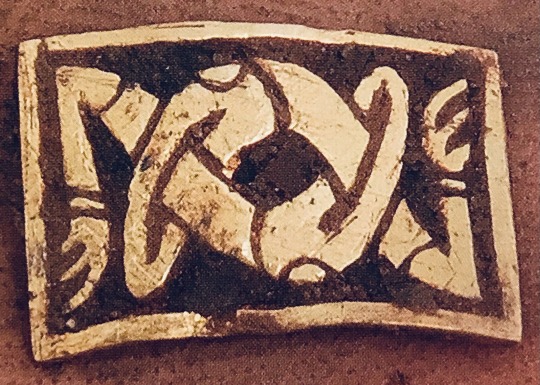
A small gold plate featuring two interlocked animals with single feet, their jaws gripped around each-others throat.
One of over 1600 items discovered in 2009, known as the Staffordshire Hoard. Believed hidden during the seventh or early eighth Century, it is the largest collection of Anglo-Saxon gold ever found.
#gold#vintage jewellery#anglo saxon#treasure#treasure hoard#art#ancient art#ancient britain#staffordshire
22 notes
·
View notes
Text
Mithras, the Soldier's God: A Roman Secret Society? - Historic Mysteries
Mithras, the Soldier’s God: A Roman Secret Society? – Historic Mysteries
https://www.historicmysteries.com/mithras/
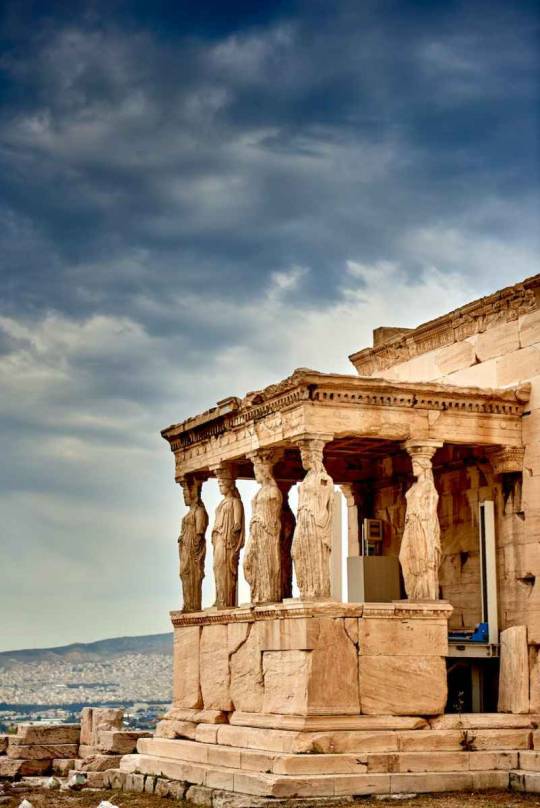
View On WordPress
#1st century#4th century#Ancient Britain#Ancient Greece#Ancient Rome#bull#cave#cavern#cyropaedia#Cyrus the Great#December 25#Greek Pantheon#Iran#Luna#Mithra#Mithraism#Mithras#monotheism#mystery school(s)#Numidia#Patron God#Persia#polytheism#Roman Empire#Roman Pantheon#sacrifice#Sol#Soldiers#syndexoi#tauroctony
28 notes
·
View notes
Text
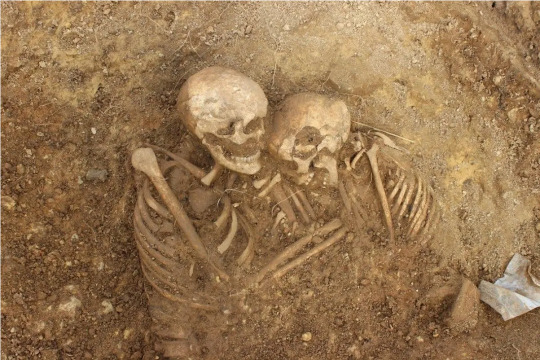
two skeletons found buried together in a roman/anglo saxon gravesite in leeds, yorkshire. ○
#death#archaeology#roman britain#the roman empire#anglo saxon#ancient britain#british history#england#english history#skeleton
19 notes
·
View notes
Text
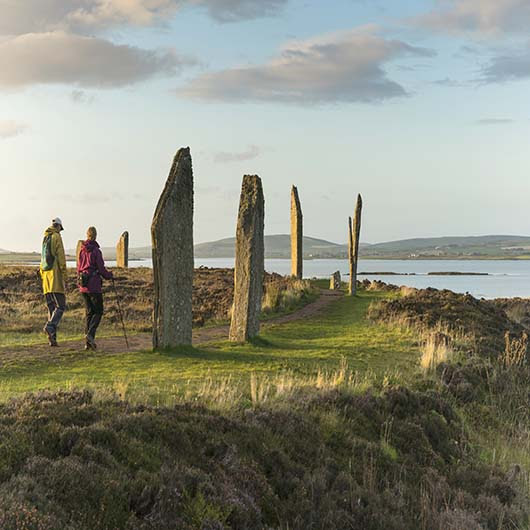
The Ring of Brodgar on Orkney predates Christianity by millennia, so the term pagan is used quite loosely. It was all our ancestors knew.
#Ring of Brodgar#Orkney#Scottish islands#standing stones#pagan monuments#stone circle#prehistoric#ancient britain#UNESCO World Heritage#mystical#remote#Scotland#UK
57 notes
·
View notes
Text
This is absolutely incredible to me - Must Farm, a Neolithic village that was destroyed by fire and so was preserved (think British Pompeii) has beads which came from Iran. Ancient trade is gobsmacking.
19 notes
·
View notes
Text

arbor low, peak district
#arbor low#Neolithic#stone circle#derbyshire#35mm film#film photography#black and white#film#Neolithic stones#stone bothering#ancient stones#burial mound#ancient britain#moon#henge#stone henge
5 notes
·
View notes
Text
Vallum Hadriani
Currently reminiscing of my time spent at Hadrian's Wall a few years ago! Itching to get back and explore!


We visited as part of a university trip during our course dedicated to Hadrian's Wall! This segment was reached on foot after a (very long) drive, and is close to the Sycamore Gap! (which unfortunately we didn't make it far enough along to see).


We also visited various forts and milecastles, along with their assoicated museums - which will most likely recieve their own, seperate post in due course!

Even if you're not interested in ancient history, you can't deny the beauty and might of Hadrian's Wall!
#hadrians wall#roman britain#ancient rome#ancient history#ancient britain#vallum hadriani#vallum aelium#roman frontiers#roman fort#roman military#english countryside#english country#northern england#emperor Hadrian#hadrian#ancient scotland#scottish history#scottish archaeology#roman archaeology#university of edinburgh#edinburgh university#chaotic academia#roman milecastle#sycamore gap#scottish youtuber#there is a certain species of lychen that only grows on roman mortar but I cant remember the name of it#and its present along the line of the wall so thats kinda cool#therefore materials were brought all the way from rome to build this massive wall#very cool if you ask me#archaeolorhi
17 notes
·
View notes
Text
humorous to me when people refer to king arthur as the king of england. like, no, that is very much not correct.
4 notes
·
View notes